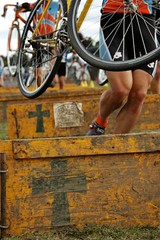 Cyclocross normally is done in cold and wet conditions -- the colder and wetter, the better. Mere mortals bundle up and watch football or sit in deer stands and duck blinds, while cyclists strip down to our bike shorts and mix it up in the freezing mud.
Cyclocross normally is done in cold and wet conditions -- the colder and wetter, the better. Mere mortals bundle up and watch football or sit in deer stands and duck blinds, while cyclists strip down to our bike shorts and mix it up in the freezing mud.Cyclocross is a style of bike racing and the bikes used in those races. Cyclocross involves racing several laps around a course with a variety of conditions -- including dirt or mud -- and steeplechase-type obstacles in which the racer must quickly dismount, hop the obstacle and remount the bike.
Cyclocross (aka CX or cross) bikes resemble road racing bikes with their drop handlebars and general frame design. Traditionally, CX bikes had a higher bottom bracket than road bikes. CX bicycles have cantilever brakes so mud doesn't gunk up the works and much greater wheel clearance for the bigger knobby tires used in cross racing.
CX bicycles are often favored by urban commuters. The big tire and brake clearances means you have room for fenders and fat, comfortable tires. Top-tube mounted cables and a (sometimes) single chainring means less maintenance. Relatively lightweight means nimble sprinting through traffic.
BSNYC gives his cyclecross primer. The "pit bike" he mentions is an extra bike that you're allowed to have. CX is so gnarly and grimy that racers keep an extra bike in the pit. When your race bike gets so muddy that you can no longer turn the wheels, you trade out for the pit bike. Your honey quickly cleans the bike while you dirty up the other bike. Wash, rinse, repeat.
Frank in Illinois writes about the pounding he took racing cyclocross this last weekend. And Masiguy took his cross bikes on the trails, crashed, and lived to blog about it.

Cycloku just for you:
ReplyDeleteWhat is cyclocross?
An exercise in real pain.
And it looks dumb, too.
I did manage to stay upright far more than I normally do on those trails. Maybe it really IS all about the bike...
ReplyDeleteI've never found that top-routed cables reduce maintenance. Rather the opposite, in fact, because sections of cable housing leading the cables back down to where they are actually used tend to collect water from the upturned end.
ReplyDeleteCrashing over those barriers sure can be painful.
ReplyDelete